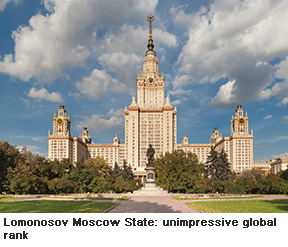 At an astonishing 787ft (240m) tall, the vast tower of Lomonosov Moscow State University dominates the skyline of Russia’s capital. Inaugurated shortly after Stalin’s death in 1953, his “temple to Soviet science” remains the world’s tallest university building and can be seen by Muscovites for miles in every direction. But while the tower — more than three times as high as London’s Senate House library and Europe’s tallest building until 1990 — is awe-inspiring, the international standing of Russia’s universities does not reach such heights.
At an astonishing 787ft (240m) tall, the vast tower of Lomonosov Moscow State University dominates the skyline of Russia’s capital. Inaugurated shortly after Stalin’s death in 1953, his “temple to Soviet science” remains the world’s tallest university building and can be seen by Muscovites for miles in every direction. But while the tower — more than three times as high as London’s Senate House library and Europe’s tallest building until 1990 — is awe-inspiring, the international standing of Russia’s universities does not reach such heights.
In the Times Higher Education World University Rankings 2014-15, Moscow State — Russia’s most prestigious and highest-ranked university — is placed 196 in the world, and occupied positions in the low 200s during the previous four years. Meanwhile, Russia’s oldest higher education institution, Saint Petersburg State University — the alma mater of eight Nobel laureates, dozens of world-renowned scientists and Russian president Vladimir Putin — has failed to break into the Top 400, despite an illustrious history spanning almost 300 years. Siberia’s Novosibirsk State University, founded in 1959, is the only other Russian institution to make the Top 400.“Russian universities are a bit like collapsed stars — they are still giving off light, but what produced that light disappeared many years ago,” says the vice rector at one Russian university, who asked not to be identified.
In an attempt to fix the problem, in 2013 Putin launched an ambitious plan, Project 5-100, which aims to place five Russian universities in the world’s Top 100 by 2020. One of its key objectives is to ensure that at least 10 percent of Russia’s academics and researchers and 15 percent of its 7 million students come from abroad. The resources associated with this scheme are currently concentrated on 15 universities, with more set to be cut out of the group each year in an X Factor-style elimination to decide the final five.
However, investment in Project 5-100 is relatively modest, with about 44 billion roubles (£448 million or Rs.4,256 crore) available for 2013-16. In comparison, Germany committed €1.9 billion (£1.4 billion) for the first stage of its Excellence Initiative (2006-2011) and France put €7.7 billion into plans to improve higher education, according to a European University Association report published last December.
Project 5-100’s international spending power has also been hit by the collapse in the rouble’s value amid falling oil prices and sanctions imposed by Western governments. With economists predicting that the country could be facing its first recession in five years, the present economic climate is likely to cripple efforts to recruit researchers from overseas. Moreover, Russia’s pariah status in the wake of its sudden invasion and annexation of Crimea and warmongering in eastern Ukraine will also do little to help academia improve its international links.
One of the toughest parts of Project 5-100 is likely to be convincing international researchers, particularly emigre Russian scientists and young academics, to consider a career in Russia. But deputy education and science minister Alexander Povalko is confident that top talent from both Russia and abroad can be tempted into the sector. “We are fighting for talent, no matter what their nation, alma mater or current affiliation. This task is relatively easy: just create strong motivation by salary, comfortable environment, unique research equipment and fascinating career perspectives,” he says.
(Excerpted and adapted from )